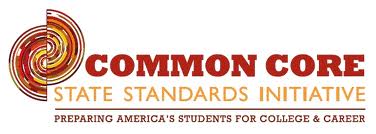Common Core Standards 101
 The Common Core Mission Statement: The Common Core State Standards provide a consistent, clear understanding of what students are expected to learn, so teachers and parents know what they need to do to help them. The standards are designed to be robust and relevant to the real world, reflecting the knowledge and skills that our young people need for success in college and careers. With American students fully prepared for the future, our communities will be best positioned to compete successfully in the global economy. The creation of the CCS Standards was a collaborative effort led by the National Governors Association Center for Best Practices and the Council of Chief State Officers. The first edition of the CSS Standards was published in June 2010.
The Common Core Mission Statement: The Common Core State Standards provide a consistent, clear understanding of what students are expected to learn, so teachers and parents know what they need to do to help them. The standards are designed to be robust and relevant to the real world, reflecting the knowledge and skills that our young people need for success in college and careers. With American students fully prepared for the future, our communities will be best positioned to compete successfully in the global economy. The creation of the CCS Standards was a collaborative effort led by the National Governors Association Center for Best Practices and the Council of Chief State Officers. The first edition of the CSS Standards was published in June 2010.
The Common Core State Standards are coming and Bound to Stay Bound is committed to providing you the support you need. “We already have a user-friendly tool on the BTSB website for finding out what titles will help support any given standard. By the time school starts in the late summer and early fall, we expect to have many more books correlated to every standard at every level,” notes Lori Smith, Customer Satisfaction Manager at Bound to Stay Bound Books. Publishers are jumping on board, too–Lerner, Penguin and others have already correlated their titles to specific standards. At the moment, not every single state has adopted the CCS Standards and each state that has adopted them is choosing their own implementation schedule. The best place to find out if your state is participating in the CCS Standards and what the timeframe is would be your state department of education.
Author and educator Lester Laminack has straightforward advice for teachers and librarians who want to prepare for the advent of the CCS Standards: “Read them.” Because they deal with multiple grade levels, librarians need to be familiar with the ten anchor standards for reading and writing. Teachers will need to know the standards for their grades. Lester suggests teachers and librarians “zero in on the overview–it’s very clear in the opening lines that this is not a curriculum, it is a set of standards.” Think of it this way,” suggests Laminack, “the standards are the building codes, the curriculum is the blueprint.”
Just as architects need to know the codes to create beautiful and functional buildings, librarians need to know the standards in order to build a collection that meets the needs of teachers and students getting ready for colleges and careers. For example, one reading anchor focuses on the ability to recognize central themes within and across texts. “Talk to teachers about what those themes are,” urges Lester. “Put together collections around those central themes.”
Another broad category homes in on the integration of knowledge and ideas. Think about the critical ability to compare and contrast texts. The standard requires two or more texts on the same topic and theme. “If I were teaching social studies, I would want historical fiction, picture books, biographies, original sources, interviews and more,” notes Laminack. “The role of the media specialist is going to increase because there is no way teachers can keep all the sources together on top of everything else they have to do. It makes so much more sense for librarians to join with teachers in looking across the entire curriculum and pull together those common threads, ensuring that they cover every angle of literacy possible.”
As it says in the Mission Statement above, the goal of the Common Core State Standards is to prepare students for the global economy. The first step is to study the standards and think both creatively and collectively.
For further information about the CCS Standards visit www.corestandards.org.
